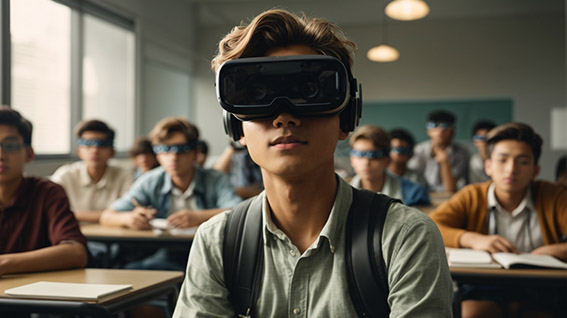The use of new technologies for language teaching has become the perfect complement to a complete education, allowing your students to have perfect English proficiency. Language courses that come with an online learning solution are more efficient, flexible, and engaging for learners, especially for all digital natives who are used to using devices for most daily chores.

Technology motivates and stimulates students
Using educational technology to learn English in and out of the classroom keeps students motivated. Indeed, today, students are generally more comfortable using digital devices when learning a language, largely thanks to tools like speech recognition and interactive multimedia exercises. For young learners, learning on a tablet or smartphone is much more stimulating than using a book.
Technology transforms students from passive recipients into active learners and enables deeper and more rewarding language learning.
Students complete their English courses through comprehensive apps that work in sync and even without the Internet. Teachers can schedule lessons to review at home before class or assign certain assignments as homework. The most interesting thing for students is all the information these apps can provide in real-time. The integration of gamification in the classroom through educational platforms is another motivating factor. Being able to randomize attendance and track it, as well as award grades and trophies to students based on their abilities and attitudes, are great ways to increase classroom interaction.
The teacher's best companion in the live classroom
In the classroom, teachers can now rely on various digital solutions to enrich traditional teaching. Thanks to educational technology, lessons have become more interesting, engaging, and fully interactive. E-learning solutions also offer the ability to switch to proven blended learning or flipped classrooms. Both methods offer a hybrid approach that encourages the flexibility and autonomy of learners. In addition, they provide teachers with a wide range of exercises and activities for different levels to promote student engagement in the classroom.
Easily manage and track student progress
Building and maintaining student rosters, course management, student assessment with tests and quizzes, and many other administrative tasks are now handled through online education platforms. Online education offers a multitude of features tailored to the needs of education centers.
On the one hand, they allow educational institutions to have the best and most efficient control over activities such as activating student accounts, creating groups, sending automated communications and notifications, and more. On the other hand, important tasks such as tracking student progress through software are now possible so as to check whether the goals have been achieved or not for activities or exercises to be reviewed in class.
Create a unique experience for both teachers and students
The use of the flipped classroom approach in English lessons, combined with complementary technology, turns the classroom into an optimal collaborative environment through idea sharing, debate, and project work. It is a way of implementing creative and participatory spaces. As a result, English lessons become more motivating for students as teachers have less time to speak and encourage student participation.
Communication skills
Technology-integrated classroom systems offer the possibility of coherently integrating tasks related to speaking skills. Furthermore, they do this by tapping into tools and processes (like instant messaging, presentation tools, etc.)
In this way, technology can help develop an interactive learning environment in which second-language interaction is stimulated on a regular basis and is not limited to oral tests.
Critical mind
The ability to analyze information, compare data, and understand abstract concepts are fundamental elements of critical thinking. In addition, they are also a great motivation to improve foreign language mastery.
This technology is useful in creating a rich learning environment where the interaction with the virtual environment complements the teacher's explanation. Active use of a second language can be encouraged to perform activities such as problem-solving and information retrieval. These activities require the activation of cognitive processes based on critical thinking.
Promote interactivity and collaboration within learning
New technology allows students to be more creative and participatory in the classroom. They prepare a basis of knowledge outside the classroom by engaging with all the content in the course, and when they arrive in the classroom, they share this knowledge. Educational technology allows students to be better prepared for class and also provides teachers with attractive resources to make their classes much more human and sociable. All students have the opportunity to participate in every activity.
When used alongside traditional teaching, new technology can differentiate between educational centers, taking English teaching one step further by paying attention to diversity in the classroom and enriching the language learning process. Investing in technological tools to improve language learning is not only a way to improve the quality of education but also a way to make the most of the material benefits of internationalization, such as increasing funding and revenue generation, strengthening international capacity building, and improving the quality of research and development.













